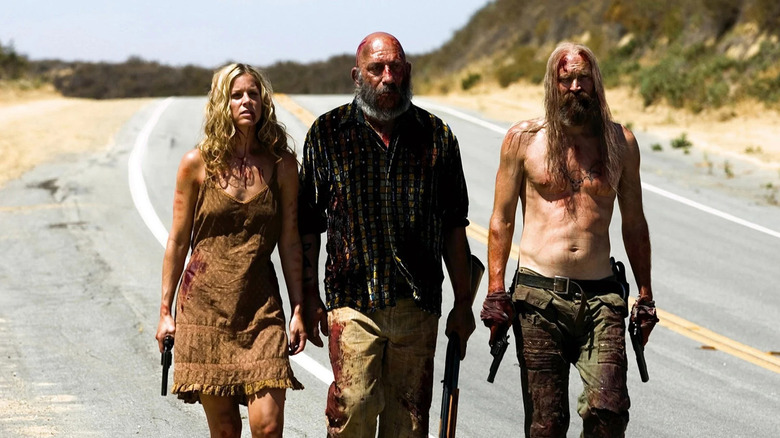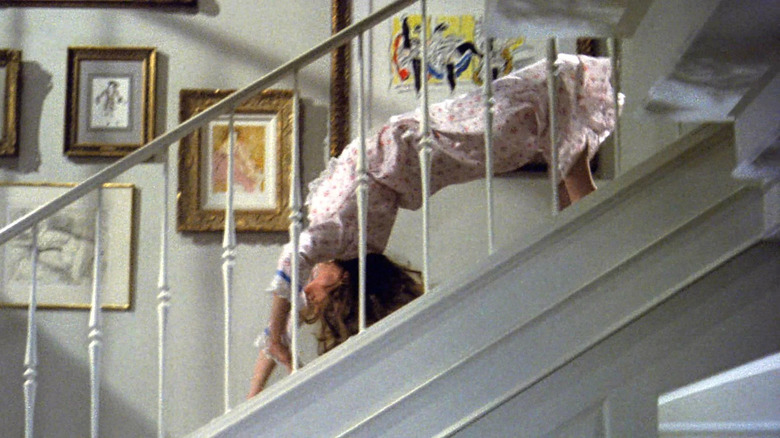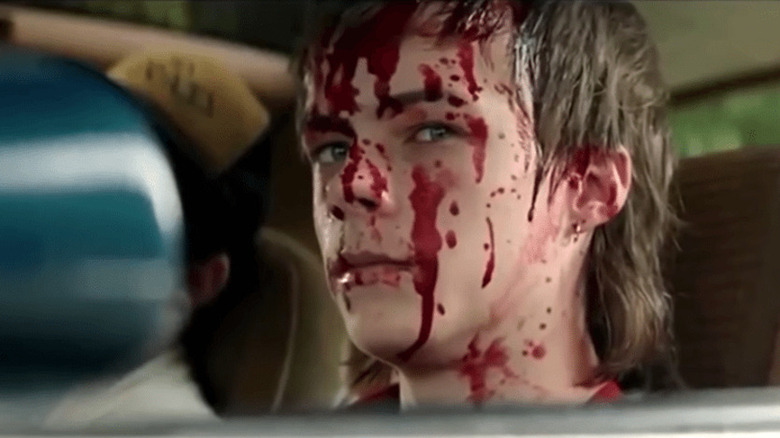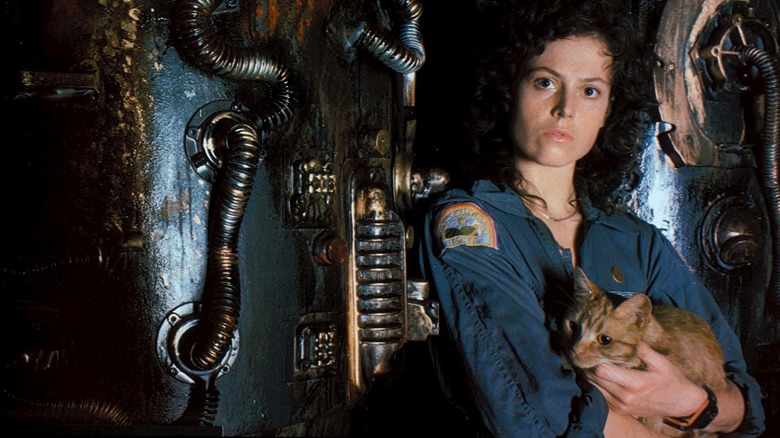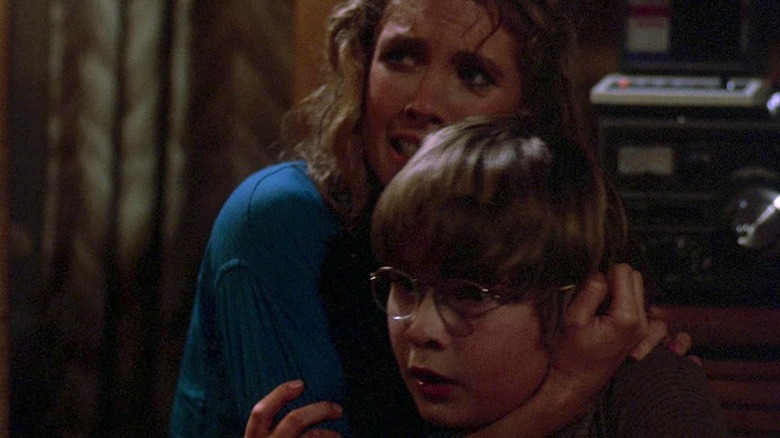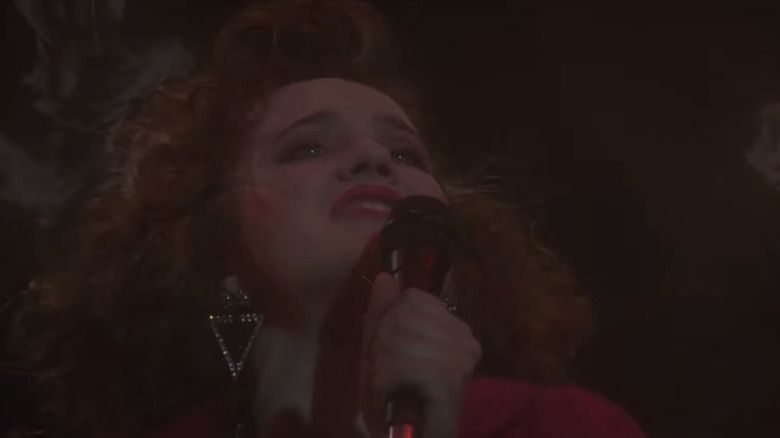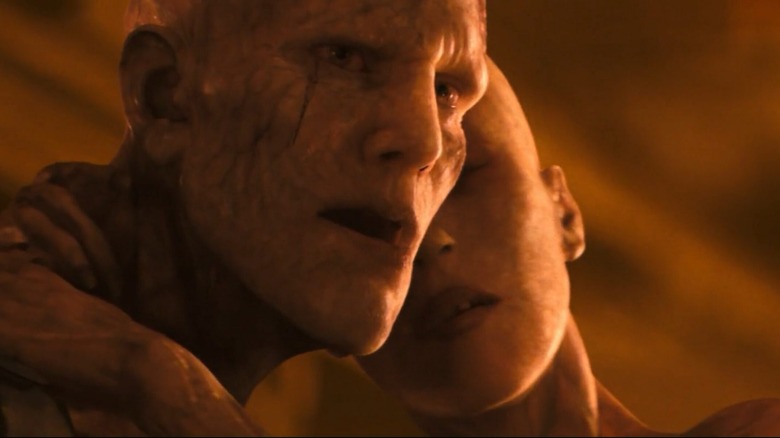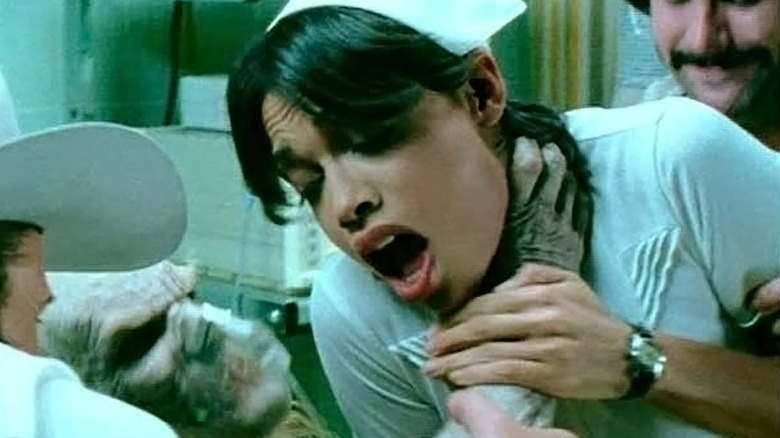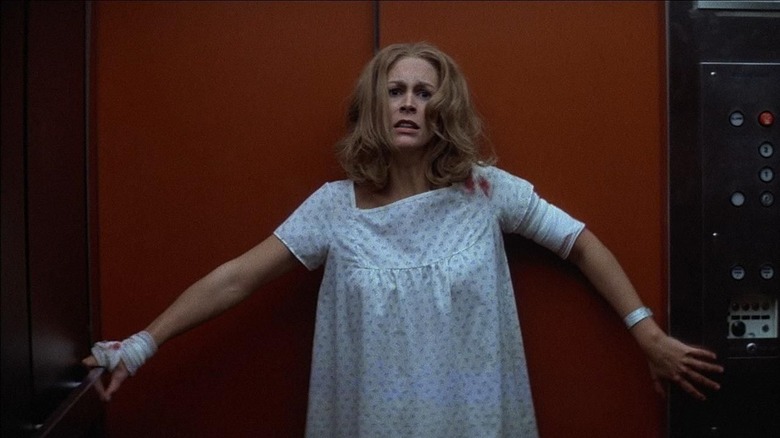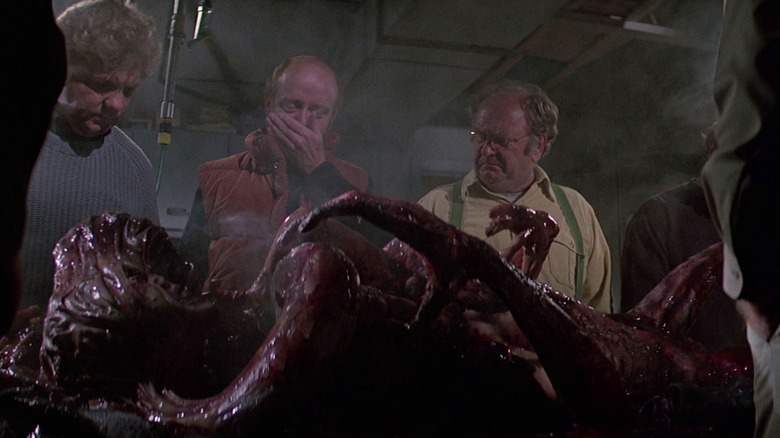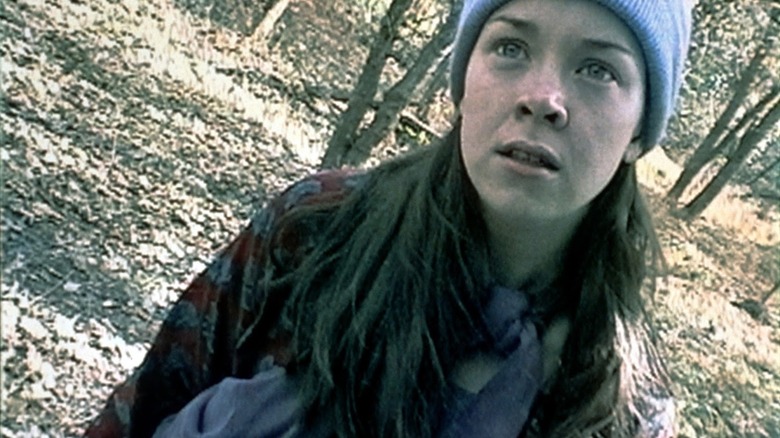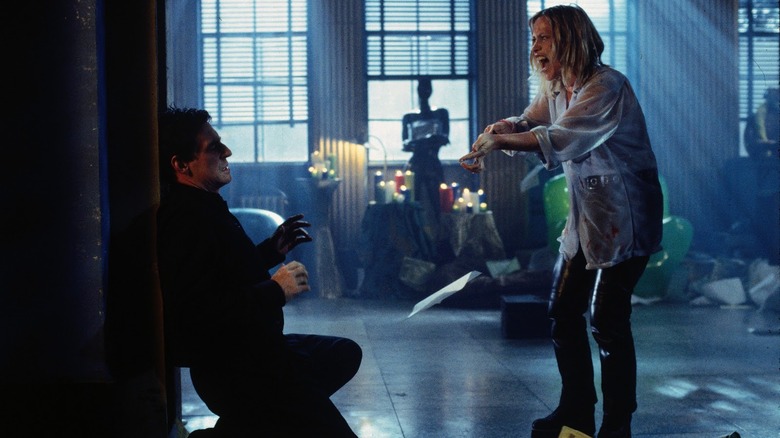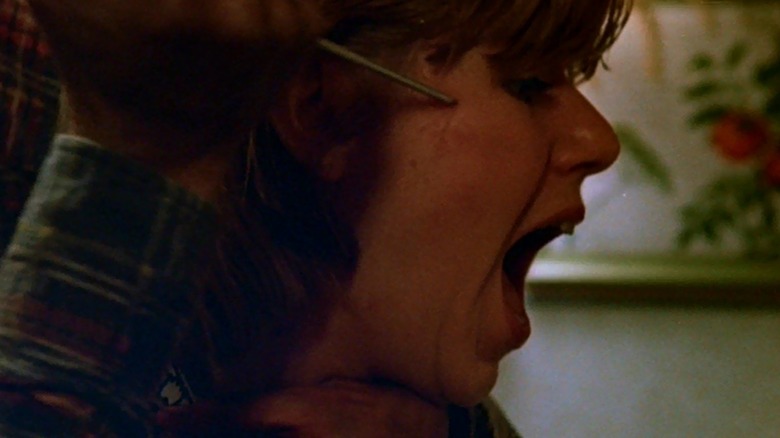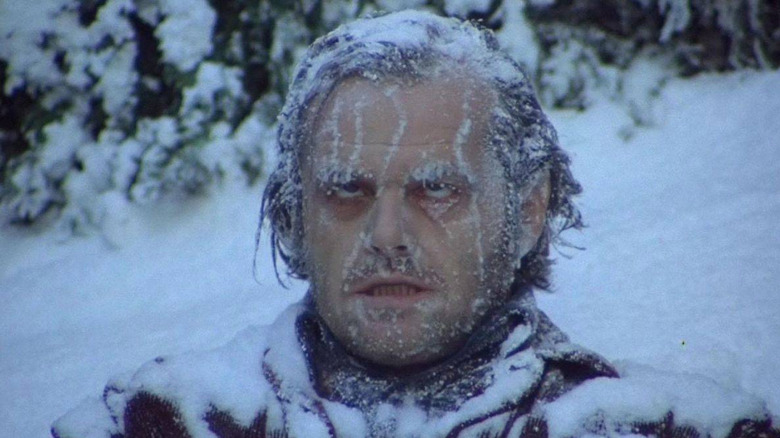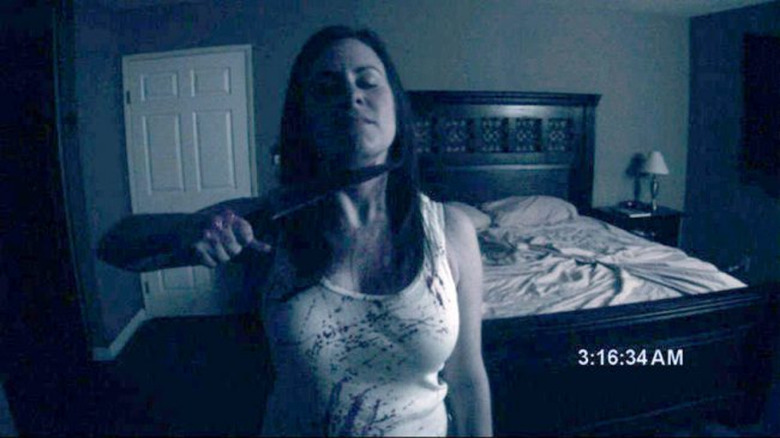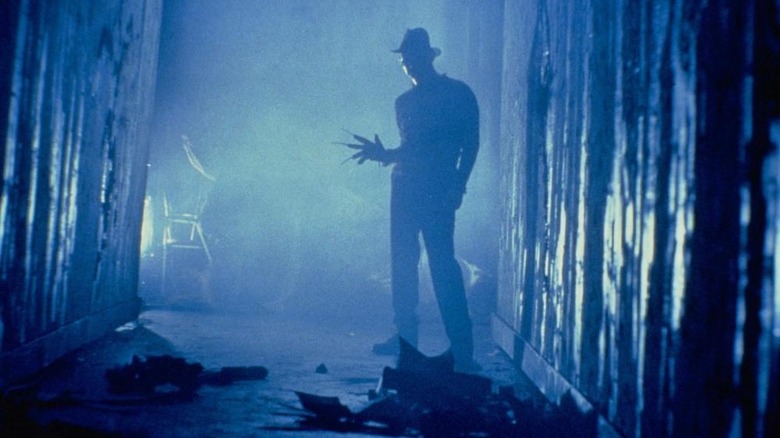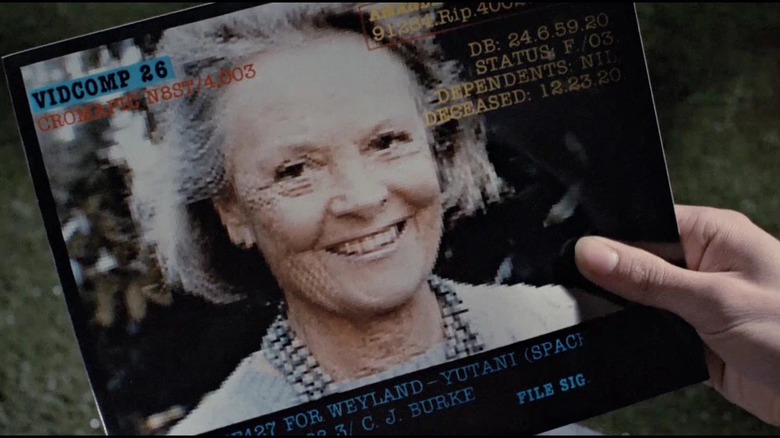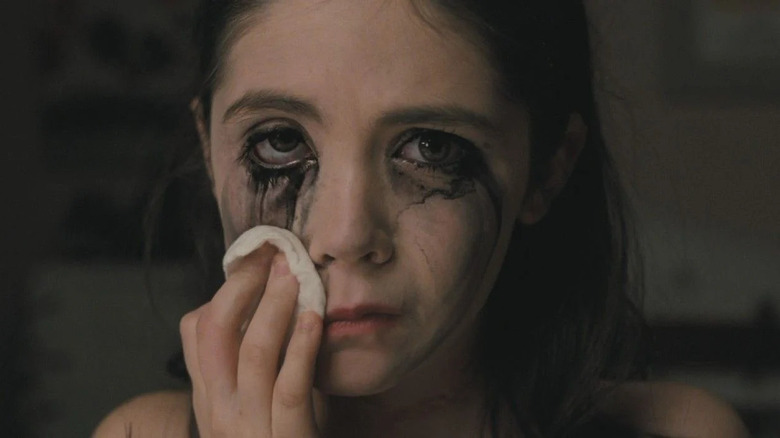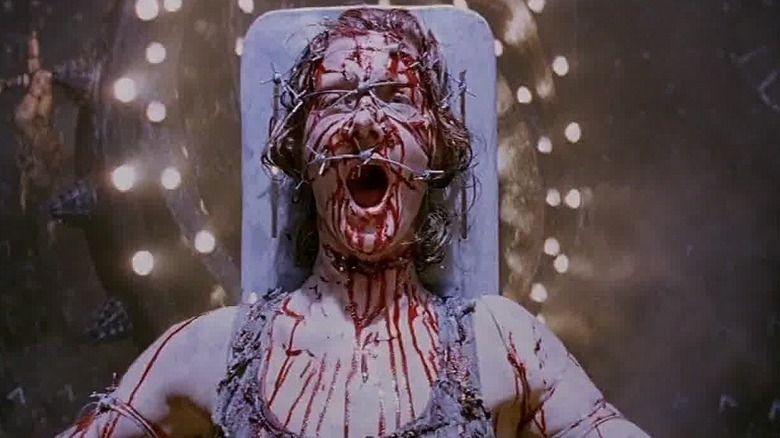The 18 Best Horror Scenes Left On The Cutting Room Floor
The movies audiences know and love often wind up with a lot of footage that doesn't make the final cut. Deleted scenes make their way onto special-edition Blu-ray releases and anniversary collections where they make us wonder what could have been. From James Cameron's massive additional exposition in "Aliens," the intense and horrifying visions from hell in "Event Horizon," and even the lost footage from Stanley Kubrick's alternate ending of "The Shining," deleted scenes can completely change the tone of a film. But, not all deleted scenes are created equal — some deserve to be left on the cutting room floor. For instance, a boring deleted scene from "Cannibal Holocaust" involving piranhas doesn't need to be here. Similarly, the deleted scene from "The Fly" where Seth Brundle accidentally fuses a cat with a baboon can sit this one out.
These, however, are the cream of the terrifying crop.
The /Film crew has put together a list of some of the absolute best deleted scenes from horror movies. The selections range from short clips to whole plot points and character arcs, and alternate endings abound from some of your favorite scary movies. So why did these scenes get the axe, and what do they add to the movies they were cut from? Read on to find out. Naturally, spoilers abound.
The Exorcist
In "The Exorcist," a little girl named Regan (Linda Blair) is possessed by a demon and her mother enlists the help of Catholic priests to exorcise her child. Signs of Regan's possession start early in the theatrical cut of the film with the help of makeup, some impolite bodily functions, and a bit of nasty dialogue, but other versions show something much, much scarier. In a scene taken directly from William Peter Blatty's novel, young Regan walks backward down the stairs on her hands and feet, flicking her tongue like a lizard, before chasing after her mother's friend.
Director William Friedkin ended up cutting the sequence from the movie because the special effects didn't work quite how he had imagined. Wires to help Blair's stunt double were too obvious, and he felt that it threw the audience into the deep end too quickly.
In 2000, Friedkin released a new cut of the film that restored what would come to be known as Regan's spider-walk, using additional footage with blood dripping out of her mouth and removing the wires digitally. The final result was truly terrifying and finally helped realize Friedkin and Blatty's vision.
While the spider-walk looks a little silly these days, its legacy is even more important than the scares it created. Regan spider-walked in "The Exorcist" so that Kayako in "Ju-On" could spider-run, delivering one of the scariest sequences ever shot on a stairwell. It's hard to put a finger on just why people using staircases incorrectly is so disturbing, but it does make a bold case for elevators in every building. (Danielle Ryan)
It: Chapter One
Stephen King's 1000+ page novel was bound to lose something in translation when Andy Muschietti adapted it for screen starting in 2017. Still, the story about a killer clown that personifies childhood fears has never looked better than it did in "IT: Chapter One," a streamlined film that's satisfying both as a horror movie and a bittersweet coming-of-age tale. But a few details about the blood-soaked progression of one character were left to our imaginations.
In the film, Nicholas Hamilton plays Henry Bowers, a bully hell-bent on making the members of the Losers Club miserable. Like several of our young heroes, the villain has his own dangerous dad to deal with, and he does so by stabbing him in the throat after being egged on by a vision of Pennywise. A deleted scene shows that Bowers went even further, killing his right-hand goons Vic (Logan Thompson) and Belch (Jake Sim), too.
The brief deleted scene takes place just as the Losers Club enters Neibolt House for the second time. A blood-covered Bowers whistles a shapeless tune from the front seat of his car, then says, "Like lambs to a slaughter. Wouldn't you say, fellas?" The camera then cuts to reveal his passengers — two very dead, very gory friends. "Yeah," he continues, on the verge of manic laughter, "Sure you would."
While this scene isn't necessarily essential (it isn't in the book), it gives Bowers' reappearance at the end of the film far more context. He even bleats at them like a lamb in his next scene, something that makes no sense without the "lambs to the slaughter" line. The moment also shows that Bowers is fully under Pennywise's influence, hurting everyone around him with little discernment, all of which would make his return in the film's climax more harrowing. (Valerie Ettenhofer)
Alien
It's probably no surprise that Ridley Scott's 1979 sci-fi horror movie "Alien" contains hidden gems in the film's deleted scenes, including the gruesome fate of Captain Dallas. In the theatrical cut of "Alien," viewers are simply led to believe that Dallas is killed by the Xenomorph in a botched heroic attempt to pursue and capture it in the air ducts of their ship. However, a deleted scene tells a different story. In it, Ripley's escape from the Nostromo includes the discovery of both Captain Dallas and Brett the engineer who have been cocooned by the alien the same way someone might shroud leftover cake in plastic wrap. Brett is clearly beyond saving, but Dallas is still technically alive, although he is also a lost cause. Knowing this, he weakly murmurs "kill me" to a horrified Ripley.
In a bonus audio commentary track for the 2003 DVD release of "Alien," screenwriter Dan O'Bannon explains that the purpose of the scene was to show that Brett's body had been converted to an alien egg, while Dallas was being preserved for the prestigious honor of facehugger implantation. In that same track, director Ridley Scott says that the scene was meant to illustrate that both Brett and Dallas are being simultaneously transformed and consumed by the alien organisms for reproductive purposes. No wonder Dallas begged for death.
Ultimately, the scene was cut. This was partly due to the fact that it did not look realistic enough when compared with the rest of the film, and because the encounter slowed down the pacing of the escape sequence, thus ruining the sense of urgency the filmmakers wanted to convey. The scene was later reintroduced along with other content that was cut from the theatrical release in a director's cut of the film. (Deshawn "Dela Doll" Thomas)
Friday the 13th: The Final Chapter
The fourth installment of the "Friday the 13th" franchise initially tried to follow the precedent set by the previous film's ending, but ultimately ditched the idea for something else entirely. With new teen blood ready to be spilled at Camp Crystal Lake, Jason reanimates in cold storage after having been declared dead by the coroner, ready to begin a new rampage. Of course, horny young people will never learn to stay away from the deeply cursed campsite that's become the villain's stomping grounds, with Jason mutilating and killing every boy, girl, and stray hitchhiker in sight. The oft-dubbed "final girl" in this scenario is Trish Jarvis (Kimberly Beck), whose family actually owns a nearby cabin. After unwittingly aligning herself with the latest objects of Jason's ire, Trish and her younger brother, Tommy (who happens to be a young Corey Feldman), must fight for their lives. It's Tommy who saves the day, cleverly disguising himself as a young Jason to distract the killer long enough to strike him in the head with a machete.
The film's alternate ending, however, uses a dream sequence that finds Trish and Tommy asleep on the couch of their now-dilapidated cabin. Waking to the sound of sirens, Trish eagerly awaits the police, but a strange leak has begun to spurt from the ceiling. She goes to check on it only to find their mother drowned in an overflowing bathtub, clearly Jason's handiwork. The dreaded killer appears, and Trish turns around just in time for him to go for the kill.
While this scene certainly follows in the footsteps of its predecessors, the film's theatrical ending is undeniably stronger — showing off a twisted performance from a young Feldman that implies a cyclical killing spree. Nonetheless, it's an entertaining testament to the fact that filmmakers are constantly changing their minds, both on-set and through to the final edit. (Natalia Keogan)
Nightbreed
After becoming a box office flop in 1990, master of horror Clive Barker eagerly spoke out against the final cut of "Nightbreed," believing the distributors tried to sell his film about found family and a community of monsters instead as a stereotypical slasher film. Barker believed that those in charge didn't actually understand the meaning of the film based on his novel "Cabal." For years it was believed that the unused footage had been lost, but Mark Miller, the co-head of Barker's production company, Seraphim Films, tracked down the footage and helped him release an extended 155-minute version of the film called "The Cabal Cut."
In 2014, Shout! Factory and Clive Barker joined forces to create the definitive director's cut that runs twenty minutes longer than the theatrical version and contains forty minutes of new and altered footage. One of the biggest changes made in the director's cut deals with the protagonist, Boone (Craig Sheffer), and his girlfriend Lori (Anne Bobby).
In an explosive scene, Lori sings a full rendition of Joanie Sommers' "Johnny Get Angry." Anne Bobby sang the number live to a sold-out bar, while Boone stumbles through the crowd, tripping out on pills given to him by the evil Dr. Decker (David Cronenberg). The song adds important subtext to Boone and Lori's relationship, showing that as much as she loves him, she feels distant from him. Lori is the reason Boone struggles to leave human life behind and join the monsters of the Nightbreed, and her pleading song helps establish the seeds of their tragic romance. (BJ Colangelo)
I Am Legend
Directed by Francis Lawrence and written by Mark Protosevich and Akiva Goldsman in that interim between "28 Days Later" and "The Walking Dead," the 2007 post-apocalyptic film "I Am Legend" is vaguely based on Richard Matheson's 1954 novel of the same name. It concerns one Robert Neville (Will Smith), possibly the last man alive in New York after a pandemic has transformed the rest of humanity into light-sensitive, bloodthirsty vampiric beasts (that nonetheless resemble modern-day iterations of zombies). Neville is the world's loneliest scientist, striving to come up with a cure. He incapacitates, kidnaps, and experiments on these "Darkseekers," trying serum after serum in his lab without success. The theatrical cut has a horde of Darkseekers breaching Neville's fortified residence, forcing him and two other survivors, Anna and Ethan (Alice Braga and Charlie Tahan), to retreat to the lab. Realizing that his latest serum worked, Neville hands it off to Anna and scoots the pair to safety before pulling out a grenade and sacrificing himself to wipe out the horde and save humanity.
While the ending creatively departs from that of the book, critics decried its obviousness — the hero's sacrifice is big but conventional. Following the home media release of the movie, an alternate ending surfaced that plays much closer to Matheson's story. Therein, the Darkseekers are a sentient race; the alpha male is revealed to be leading the horde to rescue his mate, the female Darkseeker that Neville has been poking with syringes. The scientist understands, and returns the female to her mate; an understanding is reached between the two men, and Neville survives along with his two companions and the world-saving cure. It's a far more nuanced ending, one that emphasizes Matheson's message about the foolish human urge to Other those different from ourselves.
Test audiences didn't care for such complexity and opted for the grenade explosion instead. (Anya Stanley)
The Devil's Rejects
Rob Zombie's 2005 ode to '70s slashers, "The Devil's Rejects," is a gory and gritty grindhouse follow-up to his 2003 movie "House of 1000 Corpses." The Firefly family, played by Sid Haig, Bill Moseley, and Sheri Moon Zombie, go on a rampage across desolate desert highways before finally facing off against the police in a showdown for the ages. They leave an impressive blood trail and plenty of corpses along the way, but one of the film's nastiest deaths didn't make the final cut.
In the first film, Dr. Satan (Walter Phelan) is a monstrous mad scientist living beneath the Firefly family compound. His one scene in "The Devil's Rejects," in which he rips out the throat of a nurse (played by Rosario Dawson) after being found and hospitalized by local deputies, was just a little too tonally different from the rest of the film. Dr. Satan is a kind of supernatural being, and "The Devil's Rejects" is supposed to be more grounded than its predecessor, so the scene was cut.
It's a real shame that Dr. Satan and Dawson didn't survive the editing room, though, because the scene features some truly gruesome practical effects. She gets her throat yanked out like a broken rubber band and collapses into a gurgling mess of blood, forever cementing Dr. Satan's terrifying legacy. Dawson would make a killer scream queen, too, so it's a bummer that her horror debut was relegated to the DVD extras. (Danielle Ryan)
Halloween II
If there's one consistent thing about Laurie Strode (Jamie Lee Curtis) across all the "Halloween" films, it's that fighting Michael Myers that night in 1978 made her a survivor. She rarely gets to acknowledge as much, though, as the never-ending horror franchise yanks her back into the fray whenever she comes within arm's reach of a moment's peace.
One of the earliest "Halloween" films actually did attempt to give Laurie a moment of catharsis. At the end of "Halloween II," we see the Shape go up in flames and tumble to the ground. Afterward, two police officers go over the body count — "ten, so far" — as a shell-shocked Laurie is placed in an ambulance while reporters look on. It's a fairly distant ending, one that feels like it's missing any real focus on Laurie herself.
The film's alternate ending, also called the "television cut," provides much more closure. In it, Laurie is terrified to see a cloth-covered man rise from the back of the ambulance, only to realize it's fellow survivor Jimmy (Lance Guest), whose fate is unknown in the theatrical cut. The scene doesn't exist just to tell us this, though, but to lend Laurie some complicated emotional relief.
"What's the matter?" Jimmy whispers. "We made it," Laurie answers through tears, before grabbing his hand and repeating herself. It's a tremendous bit of vulnerability from already-hardened Final Girl Laurie, one that hints early on at the PTSD and survivor's guilt that will haunt her for the rest of the franchise. The sequence ends with The Chordettes' "Mr. Sandman" playing over a shot of Myers' flame-engulfed mask. (Valerie Ettenhofer)
The Thing
John Carpenter's 1982 horror classic "The Thing" is one of those movies that suffered critical and commercial failure upon its initial release, only to be redeemed by the passage of time paired with critical reevaluation. Though there were several alternate endings planned, the final cut of "The Thing" features one in which two of the main characters, Childs (Keith David) and MacReady (Kurt Russell), come to an uneasy truce despite their apparent mistrust of each other. Specifically, the tired men are resigned to their fates as they have no way of escaping the frozen wasteland that once housed their research station and crewmates, many of whom fell victim to the shapeshifting alien lifeform that wreaked physical and psychological havoc upon them. This original ending was left intentionally ambiguous regarding whether Childs or MacReady (or both) had been secretly assimilated, leaving viewers to wonder if there's a chance the Thing would eventually spread to the global population.
One of the movie's alternate finales, however, was far less vague.
The edit in question featured a shot of a Norwegian sleigh dog — like the one at the beginning of the film — escaping the flaming wreckage of the destroyed research station unharmed, leading viewers to draw the conclusion that the efforts to suppress the eventual spread of the Thing were in vain. This version did not come from the film's director or screenwriter. Rather, it was the result of an edit of the film by late Universal executive Sidney Sheinberg for its network television broadcast. Director John Carpenter disavowed this ending, claiming he suspected that Sheinberg only tampered with the footage in retaliation for Carpenter's unwillingness to take his creative advice concerning the film's original final scene. (Deshawn "Dela Doll" Thomas)
The Blair Witch Project
Many hardcore horror fans have spent endless hours scouring the web for deleted scenes from "The Blair Witch Project," and for good reason. Having all but created the found footage subgenre, the terror of "The Blair Witch Project" has just as much to do with what the audience doesn't see — after all, the titular crone never even makes an appearance. However, every sliver of new information presented through deleted scenes also adds dimension to the film's paired-back paranoia, and one specific scene stands out more than any other.
In a chilling clip, we see Heather (Heather Donahue), Mike (Michael Williams), and Josh (Joshua Leonard) debating the idea of ditching their backpacks in order to move through the dense woods of Burkittsville, Maryland with greater ease. By this point, the disorientation of their situation — that of being utterly lost with the eerie feeling they're being stalked by a local urban legend — is beginning to set in, but Heather remains lucid enough to make an incredibly important decision. She encourages her crew to hold onto their possessions, hinting that they might be in the wilderness for longer than any of them might be prepared for. This also means that Heather is able to keep all of her camera equipment on her, essentially guaranteeing that the remainder of the trio's experience will be captured on film.
While the scene might not add a whole lot to the film aesthetically and its exclusion doesn't necessarily hinder the narrative, it offers vital insight into their struggle to get out of the woods that eventually consumed them. The audience is aware from the get-go that these tapes are pretty much all that's left of the trio, but the ability to understand their thought process during the ordeal is fascinating — even if their decisions don't help them get out of Maryland alive. (Natalia Keogan)
Stigmata
For a movie that made over $89 million at the box office, we certainly don't talk about the 1999 religious horror film "Stigmata" very often. National treasure Patricia Arquette stars as Frankie Paige, an atheist woman living in Pittsburgh who begins having strange and violent experiences as well as showing similar wounds to that of Jesus Christ after he had been crucified. A priest gets wind of Frankie's injuries and sends the information to the Vatican, who requests that the Reverend Andrew Kiernan (Gabriel Byrne) investigate. Kiernan bears witness to horrifying phenomena surrounding Frankie, and it soon becomes apparent that she is possessed and requires an exorcism.
Roger Ebert famously called the film "possibly the funniest movie ever made about Catholicism — from a theological point of view." For as serious as the subject matter is, "Stigmata" failed to spark the scares. However, we know of at least one deleted scene that could have possibly helped raise the stakes of the film.
Frankie, in full possession mode, yells at Rev. Kiernan and begins mutilating her own body. While this moment exists in the film, the graphic depiction was heavily edited, neutering the severity of Frankie's possession. The film also has an alternate ending where Frankie dies after receiving the fifth stigmata, instead of the theatrical ending where she survives and goes on to live a normal life.
Had "Stigmata" gone with the original and more intense moments, the film likely would have enjoyed a more enduring legacy. (BJ Colangelo)
Friday the 13th Part II
The "Friday the 13th" franchise is one of horror's most enduring, having heralded a new slasher cycle with its first Camp Crystal Lake tale in 1980. Fans love it, and it's the sequel that establishes Jason Voorhees as a vengeful killer — though he wouldn't get his trademark hockey mask for another sequel. "Friday the 13th Part 2" also held the honor of showcasing Jason's first kill. Poor Alice (Adrienne King), who went through the wringer to survive the events of the first film and Jason's murderous mother, would be dispatched in the sequel's opening.
The kill seen in theaters is pretty rough, as Alice takes an icepick to the face after finding the severed head of Mrs. Voorhees in her fridge. But the kill is only seen in profile, and there's a reason for that — it starts with MP- and ends with -AA.
The rating board gutted the gore, demanding cuts to nearly every kill scene in the movie, including Alice's death. These deleted scenes and extended footage have since shown up in a few work prints here and there, but it wasn't until Scream Factory released an impressive 4K collection of the "Friday the 13th" movies that the excised footage surfaced in a way that was accessible to fans.
In Alice's scene, the ice pick enters her right cheekbone, but the extended cut shows Jason turning Alice towards the camera, where the tip can be seen poking out like a groundhog through the left side of her nose. The actor has since claimed that her character didn't actually die in the scene, per an agreement between King and producers. One of the key reasons was safety; Adrienne King gained a nasty stalker following the 1980 release of "Friday the 13th" and wanted her character's conclusion to be "open-ended" for a possible return.
Alice did return in the 2021 fan film "Jason Rising," so maybe there's something to the claim. Long live Alice! (Anya Stanley)
The Shining
It's hard to forget the end of Stanley Kubrick's "The Shining," when an image of Jack Nicholson's frozen body fades to a photograph from 1921 in the hotel lobby with him in it. Originally, however, there was an epilogue scene set in a hospital, where Wendy (Shelley Duvall) and Danny (Daniel Lloyd) recovered after their horrific ordeal. This version of the ending made it all the way to theaters, but Kubrick changed his mind shortly after the limited release in New York and Los Angeles began, sending assistants to cut the scene out of every known copy. According to the Stanley Kubrick archive, only one surviving copy is rumored to exist.
According to Kubrick's co-screenwriter on "The Shining," Diane Johnson, the director originally wanted a scene that showed audiences that Danny and Wendy had survived and would be alright because he had a "soft spot" for them. All that exists of the epilogue now are some script drafts, continuity polaroids, costumes, and a few 35mm film trims. Even if the rumored surviving copy does exist, it's unlikely to ever see the light of day, so the legend of what it contained is all we have to go by. It would have been nice to see Wendy and Danny have a moment of happiness after dealing with the haunted hotel, but it also definitely would have taken the bite out of the movie's final moments.
While we'll never see the original hospital scene, at least fans can check out the moments between Wendy and Danny in Mike Flanagan's "Doctor Sleep," which carefully melded Kubrick's vision with the Stephen King novel upon which it was based. Wendy deserves to catch a break, even if we had to wait almost 40 years to see it. (Danielle Ryan)
Paranormal Activity
Oren Peli's low-budget found-footage horror movie took the world by storm when it debuted in 2009, dominating the zeitgeist and becoming one of the most profitable movies ever made. Like most blockbusters, though, it's not exactly the most memorable story. Years later, you'll be forgiven if you mostly associate the haunted house flick with seemingly endless scenes of Katie (Katie Featherston) standing over Micah (Micah Sloat) as he sleeps, and little else.
The alternate endings to "Paranormal Activity," however, are the stuff of legend.
The original finale includes one of horror's most overused visual tropes — a final stinger that sees the monster coming straight at the camera. After several nights of strange and threatening behavior, Katie calls Michah downstairs, where she apparently kills him. She hurls his body at the camera, then crawls up to it herself, bloodstained and fully demonic.
Granted, this is a fine ending, but Peli actually conceived of three others, two of which he shot. In an unfilmed finale reported by Entertainment Weekly, Katie kills Micah by bludgeoning him with his camera, and we see it go down all through that camera itself. In a second alternate ending, Katie feigns normalcy when the police arrive, but they ultimately shoot her.
The third and by far best alternate scene ties a brutal bow on the slow-burn movie. In it, Katie comes back upstairs after killing Micah, walking slowly into the bedroom as if in a trance. She closes and locks the bedroom door, then returns to the camera with a large kitchen knife in her hand. Then she slits her own throat. Not only is this outright terrifying, but it also aligns more with the film's eerie themes of supernatural loss of control than any of the other finales. It's a quietly chilling culmination of 86 minutes of suspense. (Valerie Ettenhofer)
A Nightmare On Elm Street
It's impossible to talk about horror without mentioning Wes Craven's 1984 slasher "A Nightmare on Elm Street." With this in mind, have you ever wondered why so many of the kids on Elm Street are only children? Well, this question is answered in a deleted scene that would later make an appearance in the bonus content of the film's special edition DVD.
In the scene, Marge (Ronee Blakley) explains to her daughter, Nancy (Heather Langenkamp), that she and the other parents conspired to execute Freddy Krueger only 10 years prior to the events of the film after a technical error forced the law to let the "filthy child murderer" walk free despite his guilt. When Nancy asks, "what gave you the right to take the law into your own hands," Marge tells her that the parents' extrajudicial slaying of Kreuger was personal; he killed the brothers and sisters of Nancy's peers. She continues with even more disturbing information, saying "You too, Nancy. You weren't always an only child," revealing that one of Nancy's own siblings had fallen victim to the pointy gloved creep.
This particular bit of information only strengthens the narrative of "A Nightmare on Elm Street," illustrating just how much of a connection the tormented teens and families have with both Freddy Krueger and each other. It also gives Nancy that much more motivation to defeat Krueger, since she'd be knowingly avenging the death of her own sibling.
Although, not wanting to succumb to a horrible, surrealistic dream death is also reason enough on its own.
While the theatrical cut of the film doesn't suffer from the omission, it definitely wouldn't have hurt to have the scene's added depth and exposition. (Deshawn "Dela Doll" Thomas)
Aliens
There's admittedly a lot going on in "Aliens," James Cameron's landmark 1986 sequel to Ridley Scott's singular sci-fi horror film, but there's also a pretty big subplot that never found its way into the final cut.
If you need a refresher, "Aliens" takes place a whopping 57 years after the events of the original film, with Ellen Ripley (Sigourney Weaver) having been in stasis after disembarking her alien-infested ship via escape pod. After finally being rescued, she frantically warns everyone about the threat of Xenomorphs, and their initial skepticism morphs into horrified belief. Still traumatized from her last encounter, she agrees to face them once again while assisting Weyland-Yutani on an investigative mission to their LV-426 terraforming colony, Hadleys Hope.
As it turns out, Ripley was meant to have an entire arc involving a daughter she left back on Earth in order to embark on her original mission aboard the Nostromo. As the years have passed at warp speed while hurtling through space, Ripley has hardly aged. Her daughter, however, recently passed away at the age of 66.
"I promised her that I'd be home for her birthday," Ripley says on the verge of tears. "Her eleventh birthday."
It's baffling that this scene was cut from the movie, as it demonstrates that Ripley is not only in shock from her most recent memories, but simultaneously grieving the loss of a daughter. This explains the immediate bond she feels with Newt (Carrie Henn), a young girl who barely escapes the alien attack on her colony. While many have attributed Ripley's protectiveness to garden-variety maternal instinct, the truth is so much more personal and devastating, while also offering our heroine a kernel of hope. If Ripley can protect Newt, it may help her cope with the death of her daughter. (Natalia Keogan)
Orphan
2009's "Orphan" introduced the world to Isabelle Fuhrman, and her performance as Esther helped cement her as one of horror's best killer kids. The film centers on Kate (Vera Farmiga) and John (Peter Sarsgaard), a couple who elect to adopt following the devastating loss of their unborn child. During an orphanage visit, the couple is immediately drawn to Esther and decides to welcome her into their family. Unfortunately, trouble seems to follow Esther everywhere she goes, and Kate begins to suspect that things with Esther are not as they appear.
As it turns out, Esther is not a little girl, but a 33-year-old woman posing as a child. The original film ends in a horrific climax featuring Kate kicking Esther into the frozen lake on the family's property, killing her and putting an end to her life of manipulation. However, had "Orphan" gone with its alternate ending, there's a chance they could have continued Esther's story with her own franchise.
As shown in the deleted scenes on the "Orphan" DVD, the alternate ending shows a scraped-up Esther reapplying her makeup and little girl clothing in front of a shattered mirror in order to greet the police, insinuating that she will once again get away with her history of destroying families. The scene is horrifying, and Fuhrman's confident stillness as she marches down the stairs, face completely cut up, is the thing of nightmares. Not one to be forgotten, a prequel film titled "Orphan: First Kill" is due out soon. (BJ Colangelo)
Event Horizon
1997 was a wild year for horror. It was a boom year for teen slashers, with "I Know What You Did Last Summer" and "Scream 2" pulling in considerable box office numbers. It was also a year of escalation; the late '90s saw a rise in envelope-pushing films like Michael Haneke's "Funny Games" prime the pump for more transgressive works in the New French Extremity in the new millennium. Science fiction got darker, too, as evidenced by Paul W.S. Anderson's space horror, "Event Horizon."
The story is a routine one of a crew investigating a long-lost ship, the Event Horizon, that returned from a black hole (and possibly Hell itself). As the crew combs the ship, they learn that the vessel contained an experimental engine that folds space and time such that the Event Horizon could leave this universe. When it returned, it brought something ugly with it.
What made "Event Horizon" stand apart from its genre brethren was its striking, heavily disturbing imagery. Its "bloody orgy" sequence depicts the fate of the Event Horizon's original crew, while a late-in-the-film "Visions of Hell" sequence inundates the viewer with just that — visions of the rescue team bound and screaming, as though they had each opened LeMarchand's Box. Neither sequence is pretty, but it's all effective; the extended footage of both the blood orgy and the visions of Hell, along with several other gory moments, had to be trimmed to calm both Paramount and the MPAA.
The film was a failure at the box office, and critics weren't much kinder. Since the movie's DVD release, however, it gained a rabid cult following which prompted fans and eventually the studio to approach Anderson for a Director's Cut. Sadly, poor archiving in the pre-DVD age led to the loss of the cut footage (which was stored in a Pennsylvania salt mine for some reason). Anderson told Crave Online, "Paramount have asked us to come back in and do different versions; we looked for the material, and it just doesn't exist."
The footage as is, still in its grainy video quality, does exist in the special features and now online for all to behold. The visions, visceral as they are, are artfully-composed shots that meld beauty with horror. Without getting too graphic, it's safe to promise that there will be blood. (Anya Stanley)
